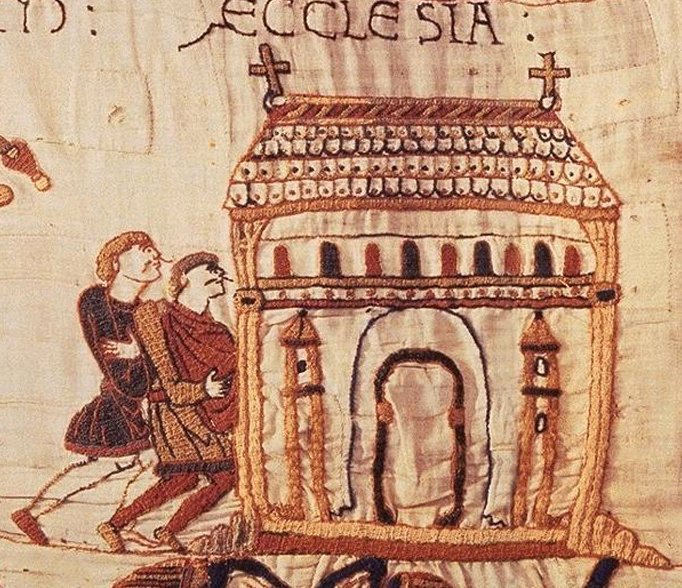Bosham

The site of Bosham church has a long history. The
church is thought to have been founded in the Roman era and around 681
when St Wilfrid (634-709/10) came to convert the local inhabitants of
this part of Sussex he found a group of Irish monks living here under
the leadership of Dicuill in:
a very small monastery in a place called Bosham
surrounded by woods and sea, in which 5 or 6 brothers served the Lord
in humility and poverty.
Around 1020 the 8 year old daughter of King Canute (d.1035) is said to
have drowned at Bosham, while in 1865 a stone coffin was found with the
bones of a child who may have been the princess. Traditionally it
was also here that Canute famously tried to halt the incoming
tide. Later, according to the Anglo Saxon Chronicles in 1049 and
1051, Earl Godwine's sons came to Bosham in their ships when the family
was in dispute with Edward the Confessor (1042-66).
By 1064 the monastery had become a church when Earl Harold of Wessex
(d.1066) set off from here on his ill-fated journey to Normandy.
The church is clearly shown in the Bayeux Tapestry with 2 towers or
turrets surrounding a Saxon arch similar to those found within the
present day edifice. The church is the traditional burial place
of King Harold, a
tradition enhanced by the discovery of a burial in a stone coffin under
the chancel arch in 1865. This was dated to the eleventh century,
while the corpse being headless and mutilated, missing one leg entirely
and the other partially, was thought to enhance the probabilities that
this was the king as after the battle his body was said to have been
savaged, much to the annoyance of King William I (d.1087). Sometime before 1066 the church was presented to Osbern Fitz Osbern (d.1103), the chaplain of Edward the Confessor
(1042-66). Osbern became bishop of Exeter in 1072 and the church
then became a property of that see, although the bishops of Chichester
also claimed the site. Bosham was also a colligate church which
meant that the canons used the chancel while the parishioners
worshipped in the nave. This was probably why the chancel was
expanded, firstly in herringbone style and then in a more normal rubble manner later.
Description
It is suggested that the church is built upon the site of the original
Roman basilica which is thought to have stood here. When the
current remains were begun is unknown but most guesses are that the
tower, its arch and the chancel arch are Saxon ‘eleventh century
and no older'.
The tower is of 4 storeys with Romanesque windows on the middle 2
floors and 4 fine twin bell openings in the uppermost bell
chamber. Internally there is a fine Saxon tower arch which is
slightly horseshoe shaped and has long and short work jambs. On
the floor above is a triangular headed doorway in typical Saxon
style. Next to it is a small, low, rectangular window which may
have served as a squint for the bellringers. The style of wall
and quoining would suggest that these lowest 2 or 3 stages of the tower
might have been built simultaneously, having as they do long and short
work quoins. The third floor apparently has walling constructed
in a slightly different manner, although again the quoins are long and
short work. On the third floor is a Romanesque doorway giving
access to the nave. Elsewhere this floor had Saxon twin lights to
north and south and just possibly the west. The top floor has
more normal quoins, so not surprisingly must have been the last part of
the tower built.
The chancel has been extended eastwards, probably in both the twelfth
and thirteenth centuries. Above the chancel arch are the
fossilised remains of doorways and windows, which again point to a
Saxon date. Herringbone masonry
can be seen in both the north and south internal walls of the chancel
in the central extension phase as well as used as patching in those
oldest walls nearest the chancel arch.
The aisles were probably added at the same time as the chancel
extensions. The crypt under the south aisle is supposed to be
fourteenth century. However, it was found to contain 2 Saxon
‘charcoal' burials which might suggest a much earlier date.
Copyright©2022
Paul Martin Remfry

